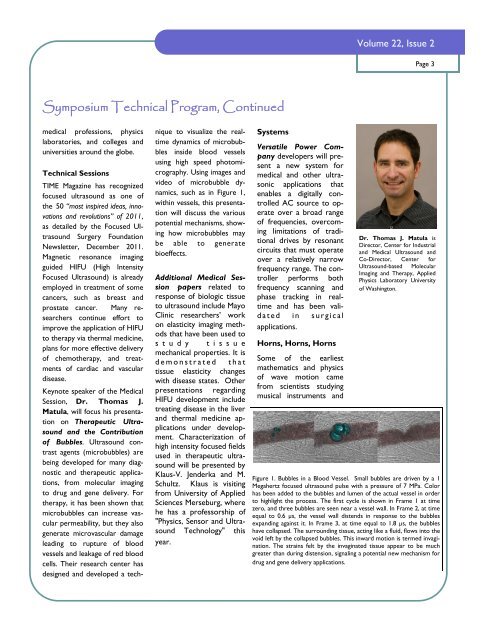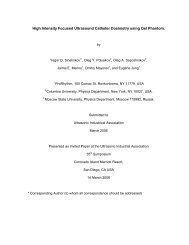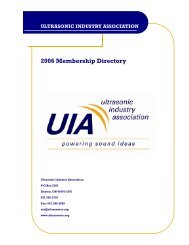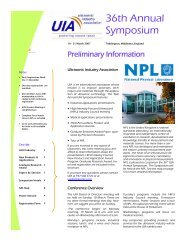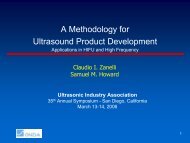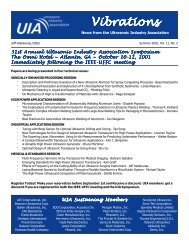2012 Spring issue of Vibrations (pdf) - Ultrasonic Industry Association
2012 Spring issue of Vibrations (pdf) - Ultrasonic Industry Association
2012 Spring issue of Vibrations (pdf) - Ultrasonic Industry Association
You also want an ePaper? Increase the reach of your titles
YUMPU automatically turns print PDFs into web optimized ePapers that Google loves.
Volume 22, Issue 2<br />
Page 3<br />
Symposium Technical Program, Continued<br />
medical pr<strong>of</strong>essions, physics<br />
laboratories, and colleges and<br />
universities around the globe.<br />
Technical Sessions<br />
TIME Magazine has recognized<br />
focused ultrasound as one <strong>of</strong><br />
the 50 “most inspired ideas, innovations<br />
and revolutions” <strong>of</strong> 2011,<br />
as detailed by the Focused Ultrasound<br />
Surgery Foundation<br />
Newsletter, December 2011.<br />
Magnetic resonance imaging<br />
guided HIFU (High Intensity<br />
Focused Ultrasound) is already<br />
employed in treatment <strong>of</strong> some<br />
cancers, such as breast and<br />
prostate cancer. Many researchers<br />
continue effort to<br />
improve the application <strong>of</strong> HIFU<br />
to therapy via thermal medicine,<br />
plans for more effective delivery<br />
<strong>of</strong> chemotherapy, and treatments<br />
<strong>of</strong> cardiac and vascular<br />
disease.<br />
Keynote speaker <strong>of</strong> the Medical<br />
Session, Dr. Thomas J.<br />
Matula, will focus his presentation<br />
on Therapeutic Ultrasound<br />
and the Contribution<br />
<strong>of</strong> Bubbles. Ultrasound contrast<br />
agents (microbubbles) are<br />
being developed for many diagnostic<br />
and therapeutic applications,<br />
from molecular imaging<br />
to drug and gene delivery. For<br />
therapy, it has been shown that<br />
microbubbles can increase vascular<br />
permeability, but they also<br />
generate microvascular damage<br />
leading to rupture <strong>of</strong> blood<br />
vessels and leakage <strong>of</strong> red blood<br />
cells. Their research center has<br />
designed and developed a technique<br />
to visualize the realtime<br />
dynamics <strong>of</strong> microbubbles<br />
inside blood vessels<br />
using high speed photomicrography.<br />
Using images and<br />
video <strong>of</strong> microbubble dynamics,<br />
such as in Figure 1,<br />
within vessels, this presentation<br />
will discuss the various<br />
potential mechanisms, showing<br />
how microbubbles may<br />
be able to generate<br />
bioeffects.<br />
Additional Medical Session<br />
papers related to<br />
response <strong>of</strong> biologic t<strong>issue</strong><br />
to ultrasound include Mayo<br />
Clinic researchers’ work<br />
on elasticity imaging methods<br />
that have been used to<br />
study t<strong>issue</strong><br />
mechanical properties. It is<br />
demonstrated that<br />
t<strong>issue</strong> elasticity changes<br />
with disease states. Other<br />
presentations regarding<br />
HIFU development include<br />
treating disease in the liver<br />
and thermal medicine applications<br />
under development.<br />
Characterization <strong>of</strong><br />
high intensity focused fields<br />
used in therapeutic ultrasound<br />
will be presented by<br />
Klaus-V. Jenderka and M.<br />
Schultz. Klaus is visiting<br />
from University <strong>of</strong> Applied<br />
Sciences Merseburg, where<br />
he has a pr<strong>of</strong>essorship <strong>of</strong><br />
"Physics, Sensor and Ultrasound<br />
Technology" this<br />
year.<br />
Systems<br />
Versatile Power Company<br />
developers will present<br />
a new system for<br />
medical and other ultrasonic<br />
applications that<br />
enables a digitally controlled<br />
AC source to operate<br />
over a broad range<br />
<strong>of</strong> frequencies, overcoming<br />
limitations <strong>of</strong> traditional<br />
drives by resonant<br />
circuits that must operate<br />
over a relatively narrow<br />
frequency range. The controller<br />
performs both<br />
frequency scanning and<br />
phase tracking in realtime<br />
and has been validated<br />
in surgical<br />
applications.<br />
Horns, Horns, Horns<br />
Some <strong>of</strong> the earliest<br />
mathematics and physics<br />
<strong>of</strong> wave motion came<br />
from scientists studying<br />
musical instruments and<br />
Dr. Thomas J. Matula is<br />
Director, Center for Industrial<br />
and Medical Ultrasound and<br />
Co-Director, Center for<br />
Ultrasound-based Molecular<br />
Imaging and Therapy, Applied<br />
Physics Laboratory University<br />
<strong>of</strong> Washington.<br />
Figure 1. Bubbles in a Blood Vessel. Small bubbles are driven by a 1<br />
Megahertz focused ultrasound pulse with a pressure <strong>of</strong> 7 MPa. Color<br />
has been added to the bubbles and lumen <strong>of</strong> the actual vessel in order<br />
to highlight the process. The first cycle is shown in Frame 1 at time<br />
zero, and three bubbles are seen near a vessel wall. In Frame 2, at time<br />
equal to 0.6 µs, the vessel wall distends in response to the bubbles<br />
expanding against it. In Frame 3, at time equal to 1.8 µs, the bubbles<br />
have collapsed. The surrounding t<strong>issue</strong>, acting like a fluid, flows into the<br />
void left by the collapsed bubbles. This inward motion is termed invagination.<br />
The strains felt by the invaginated t<strong>issue</strong> appear to be much<br />
greater than during distension, signaling a potential new mechanism for<br />
drug and gene delivery applications.


